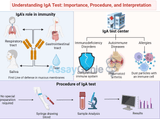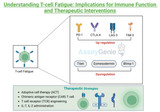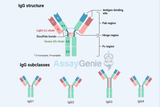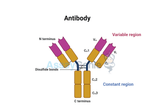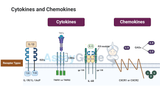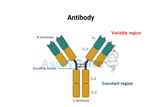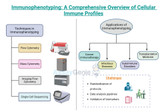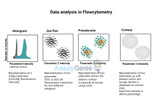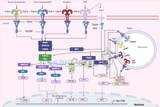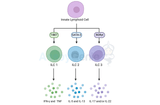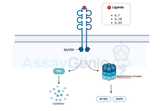Blog
IgA Testing: Complete Diagnostic Guide + Interpretation Methods | Expert Protocols
The IgA test, also known as immunoglobulin A test, is a diagnostic tool used to measure the levels of IgA antibodies in the blood. Immunoglobulin A (IgA) is a type of antibody that plays a crucial role in the immune system's defense against infections. This test helps in diagnosing certain medical conditions related to the immune system, such as autoimmune diseases and allergies. In this comprehensive guide, we will delve deeper into the importance of the IgA test, its procedure, interpretation of results, factors affecting IgA levels, and clinical significance. Importance of IgA Test: Immunoglobulin A is primarily found in mucous membranes, particularly those lining the re
…
15th Apr 2024
Understanding T Cell Fatigue: Implications for Immune Function and Therapeutic Interventions
T cells are central players in adaptive immunity, responsible for recognizing and eliminating infected or aberrant cells. Upon encountering antigens, T cells undergo clonal expansion and differentiation into effector or memory cells, executing various functions to eliminate the threat. However, in scenarios of persistent antigen exposure, such as chronic infections or cancer, T cells can become functionally exhausted, leading to compromised immune responses. This phenomenon, known as T cell fatigue or exhaustion, has garnered significant attention due to its implications for immune function and therapeutic interventions. Mechanisms of T Cell Fatigue: T cell fatigue is chara
…
9th Apr 2024
Comprehensive Analysis of Antibody Structure and Function
Antibodies, or immunoglobulins, stand as critical components of the immune system, orchestrating the identification and neutralization of pathogens like viruses and bacteria. This extensive article aims to provide a thorough understanding of the sophisticated architecture and multifaceted roles of antibodies, delving into their molecular composition, mechanisms behind their diversity and specificity, and their integral functions within the immune response. Fundamental Architecture of Antibodies Antibodies are Y-shaped molecules composed of four polypeptide chains: two identical heavy chains and two identical light chains. These chains are linked together by disulfide bonds and n
…
2nd Apr 2024
Immunoglobulin vs Antibody: Unveiling the Intricacies
In the realm of immunology, the terms "immunoglobulin" and "antibody" often find themselves used interchangeably, sparking confusion among those keen on understanding the immune system's fine details. While closely related, these terms encapsulate nuances vital for a comprehensive grasp of how the body defends itself against pathogens. This article embarks on a deep dive into the definitions, functions, structures, and types of immunoglobulins and antibodies, unveiling their similarities and differences. Defining the Players Immunoglobulin (Ig) Immunoglobulins, commonly abbreviated as Igs, are glycoprotein molecules produced by plasma cells (a type of white blood cell). The
…
30th Mar 2024
Chemokines versus Cytokines: A Detailed Comparative Study
The complex interplay between chemokines and cytokines is fundamental to the immune system's function, orchestrating the body's response to infection, inflammation, and injury. This detailed analysis explores the distinctions and connections between these two pivotal types of signaling molecules, highlighting their roles in health and disease. Deep Dive into Chemokines What Are Chemokines? Chemokines are a specialized subgroup of cytokines characterized by their ability to induce directed chemotaxis in nearby responsive cells. These molecules are crucial for the migration of cells, particularly immune cells, to sites of infection or injury. The Four Families of Chemokin
…
30th Mar 2024
Understanding Immunoglobulin Antibodies: Structure, Function, and Types
Immunoglobulin antibodies stand at the forefront of the immune defense system, offering a sophisticated mechanism for recognizing and neutralizing a vast array of pathogens, including bacteria, viruses, and other potentially harmful foreign bodies. These antibodies, also known as immunoglobulins (Ig), are produced by specialized cells in the immune system and serve as a critical component of both innate and adaptive immunity. This article provides a deeper understanding of the structure, function, and classification of immunoglobulin antibodies, highlighting their essential role in maintaining health and combating diseases. Detailed Structure of Immunoglobulin Antibodies At the
…
29th Mar 2024
Innate Immune Systemc Explained: Step-by-Step Process & Key Concepts
The innate immune system is the first line of defense against pathogens, providing a rapid response to infections. This system comprises various cell types, each with specialized roles in detecting and eliminating invaders. In this article, we delve into the intricate world of innate immune system cells, exploring their functions, types, and contributions to the body's defense mechanisms. Introduction to the Innate Immune System The innate immune system is a crucial component of the body's defense, capable of immediate action upon encountering pathogens. Unlike the adaptive immune system, which requires time to develop a specific response, the innate immune system provides a gene
…
28th Mar 2024
Unraveling the Complexities of Antibodies: Light Chains, Heavy Chains, Constant Regions, and Tumor-Associated Antigens
Antibodies, also known as immunoglobulins, play a pivotal role in the immune system's ability to recognize and neutralize pathogens. This comprehensive article delves into the structural and functional nuances of antibodies, focusing on the antibody light chain, tumor-associated antigens, constant regions of antibodies, and the interplay between heavy and light chains. By exploring these components in detail, we aim to enhance understanding of their significance in immunology and their implications in cancer research. Contents 1. Introduction to Antibodies 2. Structure of Antibodies Heavy Chain and Light Chain Constant Region of Antibody 3. Antibody Light Chain Types of Light
…
28th Mar 2024
The Rat Effectively Models Signature Cytokines of T Helper Cells
Understanding the immune system's intricacies requires models that accurately reflect its complexity. The rat, as a model organism, plays a crucial role in immunological research, particularly in the study of T helper (Th) cells and their signature cytokines. This article explores how rats model the signature cytokines of Th cells, shedding light on their contributions to immunological research. Introduction to T Helper Cells and Their Cytokines T helper cells, a subset of T cells, are pivotal in the immune system's adaptive response. They assist other cells in the immune system through the secretion of cytokines, signaling molecules that modulate the immune response. These cell
…
26th Mar 2024
Immunophenotyping: A Comprehensive Analysis of Cellular Immune Profiles
Immunophenotyping, a cornerstone of modern immunology, involves identifying and characterizing cell populations based on their surface markers. This technique provides insights into the heterogeneity and functionality of immune cells, enabling researchers and clinicians to elucidate immune responses in health and disease. Immunophenotyping has evolved significantly over the years, from early flow cytometry approaches to multiparameter analyses using advanced technologies such as mass cytometry and single-cell sequencing. Techniques in Immunophenotyping: 1. Flow Cytometry: Flow cytometry remains the gold standard technique in immunophenotyping, allowing for the simultaneous
…
20th Mar 2024
How to Choose a Secondary Antibody
The selection of a secondary antibody is a critical step in the experimental design of various immunodetection methods, including Western Blot, ELISA, immunohistochemistry (IHC), and immunofluorescence (IF). Secondary antibodies serve as crucial tools for the amplification of signal detection, enabling researchers to observe specific antigens with high sensitivity and specificity. This article provides a comprehensive guide on how to choose the right secondary antibody for your research, ensuring the success of your immunodetection assays. Understanding Secondary Antibodies Secondary antibodies are antibodies that bind to the primary antibodies, which are directly bound to the ta
…
19th Mar 2024
The Strategic Role of Secondary Antibody Incubation Times in Immunodetection Techniques
Secondary antibodies are pivotal in the detection of target antigens in various immunodetection assays such as Western blotting, ELISA (Enzyme-Linked Immunosorbent Assay), and immunohistochemistry (IHC). The choice of secondary antibody incubation time is crucial for achieving optimal signal-to-noise ratios, thereby enhancing the specificity and sensitivity of the assay. This article delves into the principles guiding secondary antibody incubation times, factors influencing these times, and practical tips for optimizing assay outcomes. Introduction In immunodetection assays, secondary antibodies are employed to bind to primary antibodies, which directly recognize the target antig
…
19th Mar 2024
Understanding Antibody Staining for Antigen Detection in Flow Cytometry
Flow cytometry stands as a pivotal technique in the realms of molecular biology and immunology, enabling the analysis of physical and chemical characteristics of cells or particles as they flow in a fluid stream through a beam of light. The core of its application lies in the ability to identify and quantify specific antigens present on the surface or inside cells. This detailed exploration aims to dissect the intricacies of antibody staining—a cornerstone method for antigen detection in flow cytometry, elucidating its principles, methodologies, applications, and the challenges it presents. Introduction to Antibody Staining Antibody staining in flow cytometry is a method that emp
…
19th Mar 2024
The Importance of Immunohistochemistry Training in Modern Scientific Research
Immunohistochemistry (IHC) stands as a critical tool in the realm of biomedical research and diagnostic practices, offering a bridge between molecular insights and the intricate visualization of tissues. This technique, leveraging the specificity of antibodies to bind to antigens in biological tissues, unveils not only the presence but also the localization of proteins within cells and tissues. The evolution of IHC from a rudimentary staining procedure to a pivotal methodology in scientific investigations underscores the necessity for comprehensive training programs. Such programs equip researchers and diagnosticians with the knowledge and skills to implement IHC effectively, thereby adv
…
17th Mar 2024
Data Analysis in Flow Cytometry: Harnessing Complexity for Scientific Insight
Flow cytometry is a powerful analytical technology employed in cell biology, immunology, and oncology research. It enables the rapid measurement of physical and chemical characteristics of cells or particles as they pass through a laser beam. The core of this technology's utility lies in its ability to analyze thousands of particles per second, providing a wealth of data on cell populations. This article delves into the intricacies of data analysis in flow cytometry, focusing on its principles, methodologies, and applications, and highlighting the critical role of advanced data analysis software and algorithms in extracting meaningful insights from complex datasets. Principles of Flo
…
16th Mar 2024
Histamine Receptors: Gatekeepers of Immunological and Neurological Responses
Histamine, a biogenic amine, plays a crucial role in various physiological processes, including immune responses, gastric acid secretion, and neurotransmission. Central to the action of histamine are histamine receptors, which are distributed broadly across different tissues and cell types. This article delves into the nature, types, and functions of histamine receptors, highlighting their significance in immunological and neurological processes. Understanding Histamine Receptors: Histamine exerts its effects by binding to specific receptors on the surfaces of target cells. These receptors are part of the G protein-coupled receptor (GPCR) family, characterized by their seven tran
…
15th Mar 2024
Exploring the Frontier of Immunotherapy: T Cell Expansion
In the realm of immunotherapy, T cell expansion has emerged as a pivotal strategy, holding promise in the treatment of various diseases, particularly cancer. T cells are a critical component of the adaptive immune system, orchestrating immune responses against pathogens and malignant cells. Harnessing the potential of T cells through expansion techniques offers a novel avenue for enhancing their therapeutic efficacy. This article delves into the mechanisms, applications, and advancements in T cell expansion, illuminating its transformative impact on medical science. Understanding T Cell Expansion T cells, a type of lymphocyte, play a central role in adaptive immunity by rec
…
8th Mar 2024
Targeting Immune Checkpoints as Cancer Therapy
In recent years, the field of oncology has witnessed a paradigm shift with the advent of immunotherapy, a treatment modality that harnesses the body's immune system to combat cancer. Among the most promising approaches in immunotherapy is the targeting of immune checkpoints. These molecular pathways are crucial for maintaining self-tolerance and modulating the immune response to prevent autoimmunity. However, cancer cells cleverly exploit these pathways to evade immune detection and destruction. This article delves into the mechanisms of immune checkpoint pathways, their role in cancer evasion, and the therapeutic strategies designed to inhibit these checkpoints, thereby reactivating the
…
16th Feb 2024
Navigating the Intricacies of Intracellular Flow Cytometry: Key Considerations
In the evolving landscape of cellular biology, intracellular flow cytometry (ICFC) stands out as a powerful technique for analyzing the complexities within cells. This advanced method extends the capabilities of traditional flow cytometry by allowing researchers to investigate intracellular proteins, signaling pathways, and specific gene expressions within individual cells. ICFC has become indispensable in various fields, including immunology, oncology, and drug discovery, offering insights that are pivotal for understanding disease mechanisms and developing therapeutic strategies. However, harnessing the full potential of ICFC requires meticulous attention to several critical considerat
…
16th Feb 2024
Targeting Immune Checkpoints as Cancer Therapy
The advent of immune checkpoint targeting marks a significant milestone in the oncological field, offering a beacon of hope for patients battling cancer. This innovative approach leverages the body's immune system to recognize and combat cancer cells, a method that stands in stark contrast to traditional therapies. This article delves deep into the essence of immune checkpoint therapy, exploring its mechanisms, benefits, challenges, and the horizon it promises for future cancer treatments. Introduction to Immune Checkpoints Immune checkpoints are critical regulators of the immune system's response to various cells, including cancer cells. They are designed to prevent the immune s
…
13th Feb 2024
Macrophage Activation: A Keystone in Immune Response and Therapeutic Potential
In the intricate tapestry of the immune system, macrophages play a pivotal role, orchestrating a wide range of biological responses that protect the body against pathogens, remove cellular debris, and promote tissue repair. Macrophage activation is a complex process, integral to both innate and adaptive immunity, influencing disease outcomes and offering promising avenues for therapeutic intervention. This comprehensive exploration delves into the mechanisms of macrophage activation, its dualistic nature, and the implications for disease treatment and immune modulation. The Fundamentals of Macrophage Activation: Macrophages, derived from monocytes, are versatile cells present in
…
13th Feb 2024
Toll-Like Receptor Signaling Pathways: A Key to Innate Immunity
In the intricate landscape of the immune system, toll-like receptors (TLRs) play a fundamental role in the first line of defense against pathogens. These receptors, essential components of the innate immune response, are adept at recognizing specific microbial patterns, initiating signaling pathways that lead to the activation of immune responses. This article delves into the toll-like receptor signaling pathways, underscoring their importance in immunology and potential therapeutic applications. Understanding Toll-Like Receptors Toll-like receptors are a class of proteins that play a critical role in the immune system by detecting microbial infections and activating the immune r
…
5th Feb 2024
Innate Lymphoid Cells Differentiation: Guardians of Immune Homeostasis
Innate Lymphoid Cells (ILCs) represent a fascinating component of the immune system, playing a crucial role in maintaining tissue homeostasis and mounting rapid responses against pathogens. These cells lack antigen-specific receptors, distinguishing them from their adaptive counterparts, yet their ability to rapidly respond to environmental cues is vital for effective immune surveillance. One of the key aspects of ILCs' functionality lies in their differentiation process, a complex series of events that shape these cells into distinct subsets with specialized functions. Understanding ILC Differentiation: ILCs are broadly categorized into three main subsets based on their cy
…
2nd Feb 2024
IL-1 Family Signaling: Unraveling the Molecular Orchestra of Immune Regulation
The Interleukin-1 (IL-1) family represents a crucial group of signaling molecules that play a pivotal role in regulating the immune system and inflammatory responses. Comprising 11 members, including IL-1α, IL-1β, IL-18, and IL-33, the IL-1 family members exhibit diverse functions in immune homeostasis, tissue repair, and disease pathogenesis. In this article, we will delve into the intricate details of the IL-1 family signaling pathway, shedding light on its components, activation mechanisms, and physiological significance. Components of the IL-1 Family Signaling Pathway: IL-1 Receptors (IL-1Rs): The IL-1 family signaling cascade begins with the binding of
…
2nd Feb 2024

